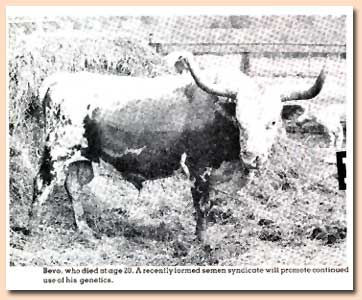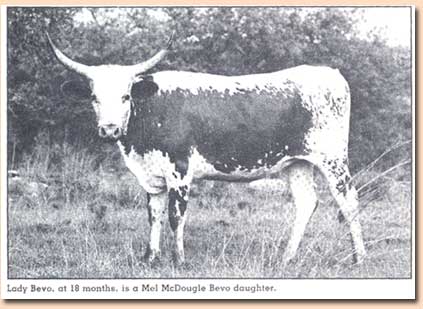 Bevo's death came at an inopportune time. Robert Harrell's cows were waiting to be pasture bred when Bevo was unloaded at Harrell's farm near Dallas. His potential as a herd sire was just beginning to be tapped- only Dewitt Meshell, Ruel Sanders and Milby Butler had used him as a herd sire to any extent.
Bevo's death came at an inopportune time. Robert Harrell's cows were waiting to be pasture bred when Bevo was unloaded at Harrell's farm near Dallas. His potential as a herd sire was just beginning to be tapped- only Dewitt Meshell, Ruel Sanders and Milby Butler had used him as a herd sire to any extent.
Then, without warning, the genetic powerhouse that produced greats like Classic, Reveille, Monarch, Butler Boy and Lady Butler stumbled, fell to the ground and died. Bevo's death was attributed to kidney failure.
The 20-year-old bull, bred by Milby Butler, died April 17,1983, and was one of Butler's favorite herd sires. "Mr. Butler thought Bevo was one of the greatest herd sires of the breed," said Dewitt Meshell.
Ruel Sanders bought Bevo in a group of cattle from the estate of Pauline Russell's husband. Meshell got the bull from Sanders in 1980.
Bevo offspring have been used extensively in breeding programs, but the sire had not been used directly to any great extent. However, technology allows an avoidance of the natural consequences of Bevo's premature death. His genetics will continue to be perpetuated with the use of frozen semen, which is being distributed though a recently formed syndicate.
Mel McDougle and Dewitt Meshell began organizing the $300,000 Bevo syndicate in March of 1984. Once the program was announced, the 10 available shares did not last long.
The syndicate members – Ken and Janet Archer, Dave and Billicarole Evans, Don and Velna Jackson, Harvey and Vera Rasmussen, George and Peggy Wilhite, Cliff and Gail Woerner, Melvin and Judy Jones, and Robert Harrell – plus recent addition Carmelo Mauro - will each receive 60 ampules of semen.
The purpose for the syndication, Meshell and McDougle say, is to ensure Bevo's full contribution is made to the Longhorn industry, by increasing the number of progeny. Syndicate members became involved for a variety of reasons.
The syndication will allow Harrell a second chance to incorporate the genetics of what he terms a 'dominant force in Butler breeding."
The reason Melvin Jones wants to use Bevo semen is because he likes Bevo's lineback coloration and horns. Bevo is able to pass on the twist-horn characteristic, Jones explained. Bevo's dam had twisted horns. In addition, Bevo's horns are slate-colored, which he prefers to white.
Other members like George Wilhite, were seeking "the great Butler genetics" that produce both horns and color. "Bevo has produced some of the greatest bulls in the breed and a line breeding strain without equal," he said.
Don Jackson is also impressed by Bevo's ability to produce outstanding herd sires. "There is a chance Bevo will produce another great herd sire, or even one better than all he has produced so far," he said.
"There is a chance Bevo will produce another great herd sire, or even one better than all he has produced so far," he said.
For Harvey Rasmussen, a new breeder, involvement in the syndicate means an opportunity for immediate recognition as well as high0impact breeding for his herd.
Horns are a significant drawing card for Longhorn breeders. Rapid lateral horn growth is predominant in Butler cattle, and this type of horn has translated into more dollars for Longhorn breeders. "Crossbreeding of other families with great straight Butler bulls is producing the longest horned animals in the breed," Wilhite said.
A cross which works particularly well is WR and Butler, Harrell noted. Butler provides the horn length and WR provides the advantage of a historic, well known pedigree. The result is a high-pedigree animal with exceptional horns. These two components have added up to the ale cattle that have demanded the highest prices on record for Longhorn cattle.
McDougle pointed out that dollars have contributed to a renewed interest in Butler genetics. "Over the past few years, Butler genetics have been responsible for generating more dollars than any other Longhorn bloodline," he said.
Jones added that horns are a reason for more dollars. "While it's true that horns are not everything, when animals are put in a sale or sold in a pasture, and you have tow of equal conformation or color, it's still the size of the horn that will sell the cow at the higher price."
Just because a bull has 55-inch horns does not necessarily mean he will pass it on. In Butler cattle, that influence is able to be passed on, Jones said.
Harrell agreed that this ability to pass on horn growth is important for breeders. "Breeders are very mindful of characteristics that bring high prices," he said. "New breeders in particular are interested in the investment opportunity. It costs no more to raise a $50,000 cow than it does a $5,000 cow."
Not only have Bevo progeny demanded the top sales prices in recent times, said Ken Archer, but they will continue to top the sales charts.
Besides horn, characteristics which syndicate members like about Butler cattle include gentle disposition, body conformation and color. "Many people object to a slid white color," Don Jackson commented. "I don't object, but Bevo throws color as well as white." He believes the white color of some Bevo offspring may be attributed to the mothers.
One way Jackson plans to promote Bevo is through the story behind the bull's name. Legend has it that when Texas Aggies beat the Texas Longhorns in football, the Aggies stole the Longhorn mascot.
They branded the steers sides with 13-10, the score of the game. Once the mascot was recovered, the Longhorns covered the seemingly permanent reminder by converting the numbers in to the letters B-E-V-O.
Jackson plans promotional spots in university football programs, and other mass-crowd places. "When you think of Bevo you think of Longhorn," he predicted.
Although Bevo's male progeny have been promoted most heavily, his daughters are also exceptional, according to Dewitt Meshell and Melvin Jones. The female Bevo progeny owned by Ruel Sanders "speak for themselves," they say.
With the high-priced semen and value of the syndicate, it is expected Bevo will be used on top cows, McDougle said. This will result in the manifestation of Bevo's top genetic quality. "Through the AI process, we will be able to explore and develop the full potential of Bevo," he added.
The first Bevo-syndicate progeny will be presented at the Golden Invitational Longhorn Sale, held April 13, 1985. Each syndicate member will have five consignments, and 20 outside consignors will be included. Cattle offered will be predominantly Butler or Butler influenced.
The Bevo Syndicate is not only continuing a trend, it is setting a trend. At $500 per ampule, Bevo’s semen represents a record syndication agreement in the Longhorn industry.
Syndicate members have reason to be optimistic – they can expect improved marketability and publicity for their herd by incorporating Bevo genetics into their programs.
Material is courtesy of LonghornJournal.com